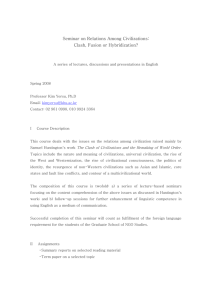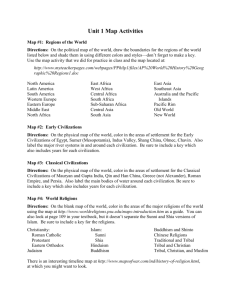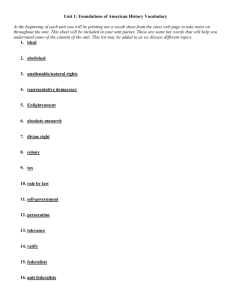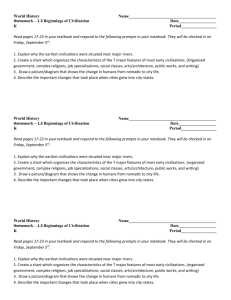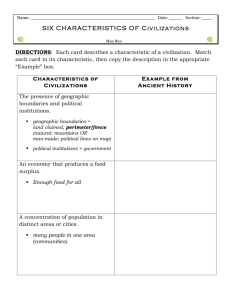Religious Freedom, Persecution, and Violence: New Findings from the
advertisement
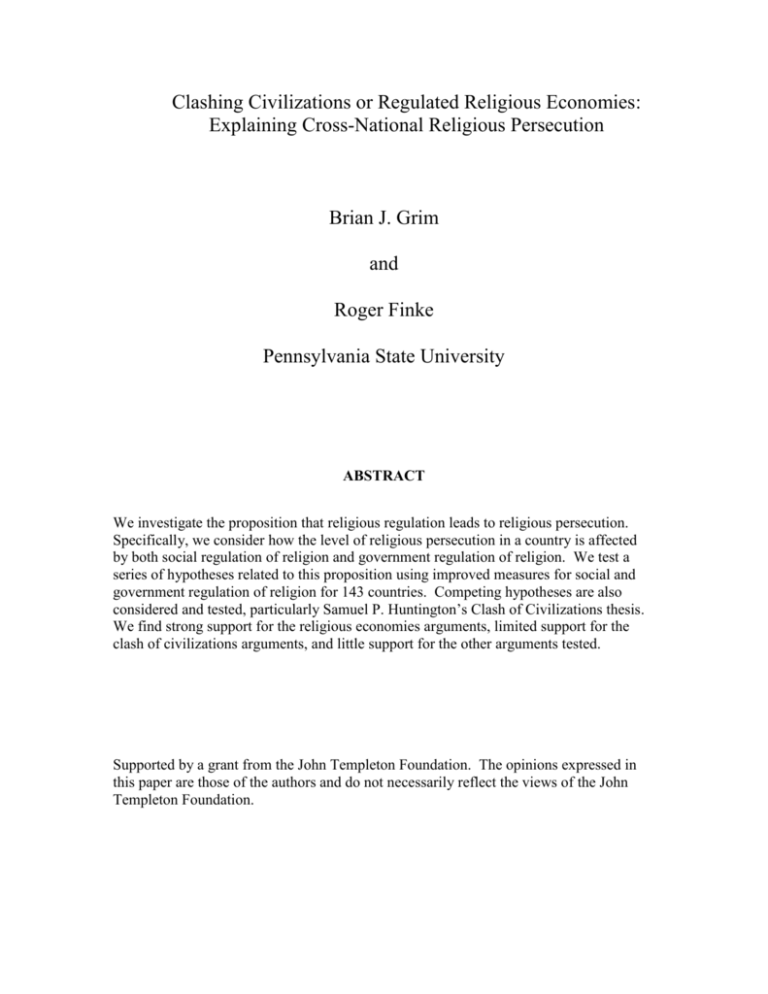
Clashing Civilizations or Regulated Religious Economies: Explaining Cross-National Religious Persecution Brian J. Grim and Roger Finke Pennsylvania State University ABSTRACT We investigate the proposition that religious regulation leads to religious persecution. Specifically, we consider how the level of religious persecution in a country is affected by both social regulation of religion and government regulation of religion. We test a series of hypotheses related to this proposition using improved measures for social and government regulation of religion for 143 countries. Competing hypotheses are also considered and tested, particularly Samuel P. Huntington’s Clash of Civilizations thesis. We find strong support for the religious economies arguments, limited support for the clash of civilizations arguments, and little support for the other arguments tested. Supported by a grant from the John Templeton Foundation. The opinions expressed in this paper are those of the authors and do not necessarily reflect the views of the John Templeton Foundation. Clashing Civilizations or Regulated Religious Economies: Explaining Cross-National Religious Persecution Religious persecution is increasingly hard to ignore. As recently as 2001 more than one million persons in Bosnia and Herzegovina remained internally displaced or were refugees as a result of the 1992-95 war where ethnic loyalties were indistinguishable from religious commitments. Similarly, the north/south civil war in Sudan which has largely pitted northern Muslims against southern Christians has led to an estimated two million deaths. Four million have fled their homes. In addition, more than two million people have been internally displaced within Darfur including 200,000 refugees fleeing to Chad. Jews, holding a long history of persecution, are still frequent targets throughout Eastern Europe and many other regions of the world. The Dali Lama continues to serve as a symbol of Buddhist persecution and Hindus remain victims of persecution in Bangladesh and elsewhere. Religious persecution is widespread. Despite the prevalence of religious persecution, religion is seldom included in the study of social conflict. In part, this is because many social science theories view religion as merely a social marker for larger forces. Economic interests and political concerns are viewed as the powerful forces fueling the flames of dissent, with religion marking the boundaries for alliances and interests. To the extent that religion is included it is often subsumed under ethnicity or other regional cultures. One of the few exceptions is Samuel P. Huntington’s the Clash of Civilizations (1993; 1996). Huntington places religion at the core of cultural divides and considers religion a source of social conflict. But his work holds assumptions that many find untenable and faces research challenges on multiple fronts. Most theories continue to ignore the role of religion in social conflicts, even when the social conflict centers on religious persecution. 1 A second reason for excluding religion from the study of social conflict is the lack of data. The most egregious forms of religious persecution are reported by the media and acknowledged by political authorities, but much religious persecution is experienced by minority religions with little power or voice in the larger culture. Moreover, the religious forces related to social conflict are poorly identified and seldom measured. Quantitative research is limited to a few measures on religious affiliation and survey data from a small sample of nations. Measures on how the state treats religion, how religions are viewed by the larger culture, and the level of religious persecution are all weak or absent. This research addresses each of these shortcomings. First, drawing on the religious economies theory, we view religion and religious persecution as more than a byproduct of economic and political forces. Religious beliefs and religious movements can mobilize actions that go beyond economic and political interests. But contrary to the implications of the clash of civilizations thesis, we argue that attempts to ensure cultural and religious consensus result in greater religious persecution. Second, drawing on data coded from the 2003 International Religious Freedom Reports, we develop measures for religious persecution and religious regulation. Combining these data with other crossnational sources allows us to test multiple hypotheses explaining religious persecution. We find strong support for the religious economies arguments, limited support for the clash of civilizations arguments, and little support for economic arguments. Explaining Religious Persecution The study of religious persecution, a specific form of social conflict, is a new contribution to the broader literature on international social conflict. Although definitions for religious persecution have varied widely (Hertzke 2004), often including 2 any form of religious opposition, we narrow the definition to physical abuse or physical displacement due to one’s religious practices, profession, or affiliation. Research on international social conflict has primarily focused on other causal factors, such as political and economic causes including hegemony of the world political economy. In contrast to such explanations, Huntington’s arguments are a bold attempt to return culture and religion to the fore in explaining social conflict. Many of the trends he identifies seem obvious and hold an intuitive appeal: civilizations of the world are organized around the major world religions and are often in conflict. Huntington highlights religion and culture in explaining social conflict. We applaud Huntington’s efforts to acknowledge the powerful forces of religion and culture, but we part company in several areas. Whereas, he assumes that the major civilizations and their religions are remarkably stable over time, we acknowledge that major changes do occur. A religious hegemony, like any hegemony, must continually be won: Spain was once a Muslim land and Algeria a Christian land; India was once a Buddhist land; the United States was once a land of native beliefs; Latin America was once indigenous, later Catholic, but may soon be evangelical. Huntington’s work implies that the blending of the major civilizations and their underlying religions will result in inevitable social conflict. We acknowledge the tension of such cultural blending, but we draw attention to the effects of regulating religious interactions. Below we review Huntington’s work and contrast it with our own arguments using a religious economies theory. The Clash of Civilizations The clash of civilizations perspective is wide ranging and, at times, general to the point of being un-testable. Huntington specifically states that his work is “not intended to 3 be a work of social science” but rather a new “paradigm” (1996:12) for the understanding of the post Cold War evolution of global politics. He explains that the world was kept in equilibrium by the alliances that squared off during the Cold War, but the collapse of the Soviet Block threw this balance out of kilter. Now, instead of geo-political alliances, “culture and cultural identities … are shaping the patterns of cohesion, disintegration, and conflict in the post-Cold War world” (1996:20). Huntington claims that these cultural identities are at their broadest level best conceived of as ‘civilizations,’ which have been primarily “identified with the world’s great religions” (1996:42). The way to avoid conflict (and we would add persecution) from this perspective is to keep the civilizations from clashing. This implies that conflict will be reduced by acknowledging the legitimacy of some religions at the expense of other religions. Though Huntington acknowledges that it is a “highly simplified” picture (ibid:29), there is a part of the picture worth testing. The centerpiece of this perspective is the thesis that “countries with similar cultures are coming together” while “countries with different cultures are coming apart” (ibid: 125), and that religion is a critical part of culture. While Huntington does not explicitly say that religion should be regulated, the overall thrust of his work is that civilization divides should be avoided in order to prevent conflict. This implies a need for greater efforts to keep the potential combatants from clashing. From this perspective, an unregulated religious market where religions have an open forum and freely compete for adherents results in societal disintegration, international conflict, and—arguably by extension—a higher level of religious persecution. When a regional religion is respected and protected, that religion can provide stability for geographic regions and the ‘civilization’ under its sway. Thus, each 4 historical religiously-related civilization should define itself around its traditional identity just as the West, i.e., “what used to be called Western Christendom” (ibid:46), should reaffirm a “commitment to Western civilization” and reject “the divisive siren calls of multiculturalism” (ibid:307). The clash of civilizations perspective on religion, however, faces a number of challenges. We highlight three. First, the clash of civilizations perspective must theoretically account for the great diversity within civilizations. It presumes that religions are intrinsically tied to specific societies and cultures, leading an analyst to proceed as if Arabs are Muslims, Chinese are Buddhists, Indians are Hindu, Europeans are Christians, and so on. In his seminal work, The Next Christendom, Philip Jenkins’ (2002, p. 6) notes that Huntington “refers to ‘Western Christendom’ as if there could be no other species.” We acknowledge that religion has served as an integrative force and is interwoven into regional cultures, but history fails to reflect Huntington’s simplified image of religious uniformity or stability. Second, the clash of civilizations perspective must overcome the ‘religious explanation’ problem, i.e., the problem of explaining social behavior based on general religious tradition. The classic example of such a general religious explanation is Max Weber’s Protestant Ethic and the Spirit of Capitalism (1930). The Protestant Ethic is intellectually captivating but empirically elusive (Stark 2004). Huntington’s work is similarly captivating and has triggered a variety of responses, some of which seek to operationalize his perspective (e.g., Beckfield 2003), and others which critique his perspective (Russett, Oneal and Cox 2000; Tipson 1997; Weede 1998). However, when social conflict is attributed to cultural differences, explanations for social behavior quickly become obscure, vague, and unsatisfying. We do not deny that general religious 5 traditions help to mold and distinguish one culture from another, but viewing social conflict from a religious economies perspective allows the identification of a common mechanism which operates across religious traditions. We believe this provides a more coherent and useful explanation for social conflict than attributing conflict to clashes between general and irreconcilable religious traditions or civilizations. And third, the clash of civilizations perspective must explain why religion is so active in the modern world. Huntington suggests that “the religious resurgence throughout the world is a reaction against secularism”, an attempt to regain past glory (1996: 98). This does not explain, however, major forms of religious resurgence throughout the world which are not primarily against a secular civil society, such as in the United States (Finke and Stark 1992), Latin America (Gill 1996), China (Aikman 2003), and Kazakhstan (IMB 2003). David Martin (2002) phrases the impact of secularism quite differently than Huntington, suggesting that religious resurgence is not a reaction against secularism but more a response to secularism which helps to deregulate religious markets. Religious economies arguments view this deregulation as essential for understanding religious resurgence. Religious Economies and the Effects of Religious Regulation The religious economies model was first developed to explain variations in religious activity. A central thesis is that when religious economies are unregulated and competitive, overall levels of religious commitment will be high (Finke and Stark 1998; Stark and Finke 2000). The theory goes on to explain that regulating religion restricts the supply of religion by changing the incentives and opportunities for religious producers (religious leaders and organizations) (Finke 1990). That is, regulated religions will face 6 increased entry and operating costs and will not compete on equal footing with religions condoned by the state. For the religious marketplace, this results in fewer religions and less effective religious organizations. For potential adherents, this leads to fewer religious options and increased costs (if they join religions not condoned by the state). Initially used to explain the surge in religious activity in America following religious deregulation in the eighteenth and nineteenth centuries (Finke 1990; Finke and Stark 1988, 1992), it has since been used to explain religious change around the globe (Stark and Finke 2000). Whether it is the surge of new religions in Japan after WWII or the recent rise of evangelicals in South America (Stark and Finke 2000) or contemporary cross-national hajj rates (Chaves, Schraeder and Sprindys 1994), this approach focuses on how regulation affects the supply, competition, and power balance between religions. We extend this argument in two significant ways. First, we increase the scope of the argument. Whereas past work has sought to explain levels of religious activity within nations, we are seeking to explain religious persecution. How does the regulation of religion contribute to religious persecution? We argue that less regulation prevents persecution by ensuring fair competition for all religions within a society. Deregulating religious markets results in a rich pluralism where no single religion can monopolize religious activity and all religions can compete on equal footing. Not only does this reduce the grievances of all religions, this decreases the ability of any single religion to wield undue political power. This argument is summarized vividly in a quote by François Marie Arouet a.k.a. Voltaire over two and a half centuries ago: “If there were only one religion … there would be danger of despotism, if there were two, they would cut each other’s throats, but there are thirty, and they live in peace and happiness” (1732). The 7 argument is simple: if governments ensure the freedom for all religions rather than taking sides with one religion or another, there will be less conflict and persecution. Though N.J. Demerath III does not speak from the religious economies perspective, the observation in his study of religion and its relation to politics around the globe succinctly lays out the argument for a free religious marketplace: Some contend that a national government can only be successful when it mirrors the surrounding culture instead of countering it, although others concur … that the state must set the rules for cultural conflict and assure an equitable framework for religious diversity (2002:124). Just as religious deregulation can generate higher levels of religious activity, it can reduce levels of religious persecution. Our second extension is more subtle, but equally important. Rather than limit our attention to the state’s formal regulation of religion, we give attention to regulatory forms that are embedded in the larger culture or in institutions and movements beyond the state. This regulation is often mobilized by a dominant religion that either lacks the authority of the state or wants to go beyond the state’s actions. Previous work has shown that even when religious economies are unregulated by the state, religious cartels form in an attempt to restrict the activities of other religions (Finke and Stark 2005). Yet this form of regulation has been largely ignored by previous tests of this theory. Religions and social movements, cultural context, and institutions beyond the state can all foster regulatory actions that lead to persecution. The religious economies theory addresses the three challenges to the civilizations perspective described above and offers an alternative understanding of the effects of religious regulation. First, the religious economies perspective accounts for the great diversity within civilizations and religious traditions. It presupposes that there are a wide 8 variety of religious preferences within any one given society (Stark and Finke 2000:193217). This presupposition also acknowledges that Arabs may be Muslim as well as Assyrian and Maronite Christians (not to mention Druze who incorporate both Christian and Muslim elements into their religion). It recognizes that Chinese may be Buddhist as well as Protestant, Muslim, Catholic, Confucian, etc. Indians may be Hindu as well as Sikh, Muslim, Catholic, Baptist, etc. Europeans and Westerners may be Christian as well as many other religions (Melton 1989). This presupposition fits the American experience of religion quite well (Finke and Stark 1992) and it certainly fits the religious diversity growing within China today (Aikman 2003). It also fits the religious diversity growing within Latin America (Gill 1996) and among traditionally Muslim Kazakhs (IMB 2003). Second, a religious economies perspective avoids the ‘religious explanation’ problem mentioned above by analyzing real social actors rather than general religious traditions. For one, it does not look to general religious traditions to provide explanations for civilizations because religious loyalties can change dramatically on both the individual and societal level. They can change on such large scales as when the Christian Byzantine Empire became the Muslim Ottoman Empire, or on such small scales as when the American boxer Cassius Clay became Muhammed Ali. For another, the religious economies perspective looks at the real actions of religions rather than just the theoretical concepts beneath the religions. Analyzing real social actors rather than general religious traditions also avoids the danger of becoming so ‘nuanced’ as to not be able to perform empirical analysis, such as is the problem with certain sociological approaches. And third, the religious economies perspective does not see ‘religious resurgence’ as a reaction to secularism but as a natural state of affairs when state regulations on 9 religion are eased. This perspective posits that the desire for religion across time is generally constant and follows a hypothetical normal distribution (Stark and Finke 2000:197). In a deregulated market it is normal to find a small number of vigorous, high tension religious groups and a small number of religious groups verging on atheism. Most religious groups fall somewhere in between those extremes. The deregulation of religion following the collapse of the USSR allowed this diversity to emerge, including a minority of religions that are aggressively attempting to fill the power vacuum. In sharp contrast to the clash of civilizations argument which implies that conflict will be less if civilizational boundaries are respected, this model suggests that when the religious marketplace faces heavy regulation from the government and other social forces, religious persecution will result. This does not mean that conflict does not occur across civilizational lines, but that the mechanism that explains the conflict is the social or governmental regulation of religion. Like previous religious economies arguments we are suggesting that religious regulation has “unintended consequences” (Finke 1990, 1997; Gill 1994; Lu 2004; also cf. Merton 1936). To test these competing hypotheses we look at religious persecution using a new source of cross-national data.1 Measuring Religion Religion’s absence from research on social conflict has been due to more than theoretical neglect. It has been due to a lack of data. Our research draws on data recently coded from the 2003 International Religious Freedom Report, including multiple measures on religious regulation and religious persecution (Grim and Finke 2006). The remainder of our measures are drawn from familiar sources of cross-national data. 1 In a longer version of this paper, we test many other competing arguments. Even when measures for economic development, social inequality, political structure, and demographic trends are included in the model, however, the significant effects of religious regulation. 10 2003 International Religious Freedom Report In compliance with the 1998 International Religious Freedom Act, each U.S. Embassy prepares an annual report on religious freedom in their host country. Once an embassy completes a report, the report is vetted by various State Department offices with expertise in the affairs of that country and in human rights. Although the initial reports were loosely structured, in 2001 they took on the reporting format shown in Figure 1. In previous work we describe the process used to code these reports. We also developed and assessed two indexes for religious regulation that will be used in this research (see Grim and Finke 2006). The first index measures the government’s regulation of religion and was defined as the restrictions placed on the practice, profession, or selection of religion by the official laws, policies, or administrative actions of the state. This index includes six items about the government’s efforts to regulate religious mission work, proselytizing, preaching, conversion and worship, as well as 11 more general legal and policy actions. The variables are reliably coded (alpha = .9468) and have a high level of internal reliability (alpha = .9161).2 The second index measures the social regulation of religion and is defined as the restrictions placed on the practice, profession, or selection of religion by other religious groups, associations, or the culture at large. Unlike the measures used for government regulation, the questions for social regulation focus on general social attitudes toward religion and the actions of social movements and religious institutions toward other religious groups, especially new, foreign, or minority religions. Rather than asking about the state’s suppression or support of religion, these questions address the restrictions religious groups face from the larger culture and other institutions.3 Once again, the measures included in the index are reliably coded (alpha = .8321) and hold a high level of internal reliability (alpha = .8047).4 Our measure for religious persecution will also rely on coding from the 2003 International Religious Freedom Report. The measure for religious persecution is a response to the question: Considering the entire Report, estimate the following: The number of people who were physically abused or displaced due to a lack of religious freedom in this country is: (0) none; (1) 1 - 10; (2) 10 – 200; (3) 201-1000; (4) 1001 10,000; (5) > 10,000. Other Sources Our remaining measures are taken from aggregate measures provided by the United Nations, the World Bank, the World Christian Database, and measures coded by Grim (2005). These measures are summarized in the Appendix. 2 See Grim and Finke (2006) for information on index construction and for a list of scores by country, The State Department Reports devote an entire section in each Report to societal attitudes (see Figure 1). 4 Again, see Grim and Finke (2006) for more details and for a list of index scores by country. 3 12 Analysis and Results Our basic proposition is that religious regulation leads to religious persecution, which is a specific form of socio-religious conflict. Specifically, we will test whether religious regulation—composed of social and government regulation—offers a strong, significant, and direct explanation for variation in the level of religious persecution. We propose that social regulation of religion will have a direct impact on the level of religious persecution as well as an indirect effect on religious persecution, working through its impact on the government’s regulation of religion. Further, we propose that government regulation of religion has an indirect effect on religious persecution by allowing religious believers to be threatened by government or other forces. In other words, laws themselves do not persecute, but they can legitimize or set free government forces to persecute. These relationships are graphically represented in Figure 2. Figure 2: Theoretical Model of Religious Persecution An alternative explanation for religious persecution is that it is fundamentally a result of civilization divides. We propose, however, that civilization divides will only partially account for religious persecution because, for among other reasons, a significant share of religious regulation is directed at rival factions of the same general religious tradition. We do believe that countries with larger populations of one religion may act differently than countries with larger populations of another religion, but we expect that 13 these differences are explainable by our model. In other words, we expect that the elements of our model will be the strongest and most direct predictors for religious persecution even when controlling for whether the country is on a civilization divide or has a larger percent Christian or Muslim. It may be that the level of religious persecution is explained by the level of armed conflict, as the two examples at the start of this paper imply. There is reason to doubt that armed conflict is a main cause. For example, the Shi’a and Kurds were persecuted for many years in Iraq by the Sunnis during years when there was no war. It also may be that rapid population growth exacerbates social tensions, and leads to religious persecution. There is some reason to doubt this in that other important things may be happening in countries with high population growth versus low growth. In low growth countries, such as in Western Europe, governments may regulate religion to protect their countries from newer religious challenges. It could be that religious persecution is explained by economic conditions. It may, however, be that good economic conditions are associated with greater liberties. Other important influences to control for include a country’s population density, the level of income inequality among the citizens, the closeness of the religion-ethnicity tie in the country, and whether persecution may decrease when women become better off. An appropriate method to test the theory-driven model summarized in Figure 2 is structural equation modeling. The model fits the data extremely well.5 Figure 3 provides 5 In structural equation modeling it is possible that more than one model can fit the data. The chi-square statistic (chi-sq=.14.427, df=18, p=.701) indicates that this model is an excellent fit with the data, i.e., any departure of the data from this model is insignificant (p=.867). Also, when the ratio of the chi-square statistic to the degrees of freedom is close to or less than 1, then the model is generally accepted. The chisq/df ratio of .801 suggests that the model fits the data very well. The three other goodness-of-fit tests reported in Figure 2 are also extremely strong. First, the Normed Fit Index (NFI) score of .981 estimates that the model is 98.1% away from the worst-fitting model Unlike the NFI, the Tucker-Lewis coefficient 14 the results of testing this model with controls for alternative explanations. Table 1 provides the total standardized effects of each significant variable upon the other variables in the model. The other variables tested in the model but which were not significant predictors are summarized in Table 2. Figure 3: Results of Structural Equation Model Test Table 1. Standardized Total Significant Effects SRI GRI Threats Persecution Percent Muslim .483 .249 .160 .217 Civilization Divide .370 .191 .123 .166 Population Growth Percent Christian Economic Strength Social Regulation Government Regulation Armed Conflict Government Threats -.242 -.156 -.093 -.372 -.239 -.143 -.282 -.331 -.198 .516 .331 .449 .642 .384 .145 .598 (TLI) is not bounded by 0 and 1. Scores close to 1 are considered to have a very good fit. This model’s TFI=1.015 indicates a very good fit. The Root Mean Square Error of Approximation test (RMSEA) produces an estimate that adjusts for sample size. This model’s RMSEA=.000 indicates an exceptionally good fit considering that a value of < .050 indicates a close fit. 15 Table 2: Summary of Variables not Significant at p < .05: Income Economic ReligionWomen Better Inequality Crisis Ethnicity Tie Off P > .100 P > .100 P = .051 P = .056 Population Density P > .100 Religious Homogeneity P > .100 Discussion and Conclusions This research has demonstrated that explanations of social conflict such as religious persecution cannot ignore the unique role of religion especially when investigating socio-religious conflicts such as religious persecution. Specifically, this research has found that religious regulation—composed of social and government regulation—offers a strong, significant, and direct explanation for variation in the level of religious persecution. Religious regulation was found to be the strongest predictor of religious persecution even when controlling for other possible explanations, including: being located on civilizational fault lines, religious homogeneity, the level of armed conflict, population growth and density, economic strength, income inequality, economic crisis, ethno-religious overlap, and gender disparity. The results showed that a state’s formal restrictions of religion contribute to religious persecution by legitimating government threats toward religious believers in reaction to pressures created by the social forces seeking to regulate religion. Another important finding is that the results remained the same even when controlling for a close tie between religion and ethnicity. The primary alternative model considered was Huntington’s Clash of Civilizations (1993, 1996), which does treat culture as a driving force, and gives religion important consideration. It was found that while Huntington’s civilization divides do help predict the level of religious persecution, they are not the key explanatory variable. The specific mechanism that leads most directly and powerfully to religious persecution 16 is not clashes of abstract civilizations, but the concrete regulatory actions of societies and governments. Different countries populated more heavily by Christians or Muslims are, however, divided at this point in time by their propensity towards social regulation (percentage of Muslims is associated with higher social regulation of religion) and government regulation (percentage of Christians is associated with lower government regulation of religion). These propensities may change. They are not deterministic. But we argue that the regulation mechanism will not. This explanation emphasizes the dynamic nature of religion within culture. A civilizational approach tends to reify religion and culture as constants from a bygone era. One final important finding to mention is that armed conflict has a direct and significant effect on the level of religious persecution. This result is in line with Gregory Hooks’ (1994) argument that war should be treated as an explanatory variable, not just an outcome variable. Despite the efforts of human rights and religious movements to heighten awareness of religious persecution, attention remains focused on a handful of cases (Hertzke, 2004). Our new source of data allows us to offer a global profile. Just as TV journalists have no story without a picture, social scientists have no story without data. The lack of data on religious persecution has severely handicapped the social sciences’ ability to study the topic. Future research will move beyond religious persecution to better understand the role of religion in other forms of social conflict. 17 References Aikman, David. 2003. Jesus in Beijing: How Christianity is Transforming China and Changing the Global Balance of Power. Washington, DC: Regnery. Arouet, François Marie a.k.a. Voltaire. 1732. Letters on England, 6 (1732) Chaves, Mark, Peter J. Schraeder and Mario Sprindys. 1994. “State Religion and Muslim Religious Vitality in the Industrialized West.” The Journal of Politics 56:1087-1097. Demerath, N.J. III. 2002. Crossing the Gods: Worldly Religions and Worldly Politics. New Brunswick, NJ: Rutgers University. Finke, Roger. 1990. “Religious Deregulation: Origins and Consequences.” Journal of Church and State 32:609-626. Finke, Roger and Rodney Stark. 1988. “Religious Economies and Sacred Canopies: Religious Mobilization in American Cities, 1906.” American Sociological Review 53:41-49. _______. 1992. The Churching of America 1776-1990: Winners and Losers in Our Religious Economy. New Brunswick: Rutgers University Press. _______. 2005. The Churching of America 1776-1990: Winners and Losers in Our Religious Economy, Second Edition. New Brunswick: Rutgers University Press. Gill, Anthony J. 1994. Rendering Unto Caesar: The Catholic Church and the State in Latin America. Chicago: University of Chicago. Grim, Brian J. 2004. “The Cities of God versus the Countries of Earth: The Restriction of Religious Freedom (RRF) Index.” Paper presented at the annual convention of the Society for the Scientific Study of Religion, Kansas City, October 21, 2004. http://gunston.doit.gmu.edu/liannacc/ERel/S5ASREC/S51_REC2004.htm _______. "Religious Regulation's Impact on Religious Persecution: The Effects of De Facto and De Jure Religious Regulation." Ph.D. Dissertation in Sociology. University Park, PA: The Pennsylvania State University. Grim, Brian J. and Roger Finke (2006 Forthcoming). "International Religion Indexes: Government Regulation, Government Favoritism, and Social Regulation of Religion." Interdisciplinary Journal of Research on Religion. Hertzke, Allen D. 2004. Freeing God’s Children: The unlikely alliance for global human rights. Lanham, MD: Rowman & Littlefield. Hooks, Gregory. 1994. “Regional Processes in the Hegemonic Nation: Political, Economic, and Military Influences on the Use of Geographic Space.” American Sociological Review 59:746-772. Huntington, Samuel P. 1993. “The Clash of Civilizations.” Foreign Affairs 72:22-49. _______. 1996. The Clash of Civilizations and the Remaking of World Order. New York: Simon & Schuster. IMB 2003. “Murphy’s Law in Reverse: The Rapid Growth of Christianity in Kazakhstan Defies Pessimists’ Logic.” Internet last accesses 11/9/04: http://www.imb.org/centralasia/path/kazak.htm. Jenkins, Philip. 2002. The Next Christendom: The Coming of Global Christianity. New York: Oxford University Press. Lu, Yunfeng. 2004. “The Unintended Consequences of Religious Suppression: Understanding the Growth of Religion.” Paper presented at the annual convention of the Society for the Scientific Study of Religion, Kansas City, October 22-24, 2004. Martin, David. 2002. Pentecostalism: The World Their Parish. Oxford, UK: Blackwell. 18 Merton, Robert K. 1936. “The Unanticipated Consequences of Purposive Social Action.” American Sociological Review 1:894-904. Project Ploughshares. 2002. “Armed Conflicts in 2001.” Retrieved February 28, 2004 (http://www.ploughshares.ca). Russett, Bruce M. John R. Oneal and Michaelene Cox. 2000. “Clash of Civilizations, or Realism and Liberalism Déjà vu? Some Evidence.” Journal of Peace Research 37:583-608). Stark, Rodney. 2004. “SSSR Presidential Address, 2004: Putting an End to Ancestor Worship.” Journal for the Scientific Study of Religion 43:465-475. Stark, Rodney, and Roger Finke. 2000. Acts of Faith: Explaining the Human Side of Religion. Berkley, CA: California University Press. Tipson, Frederick S. 1997. “Culture Clash-ification: A Verse to Huntington’s Curse.” Foreign Affairs 76:166-169. U.S. State Department. 2003. International Religious Freedom Report. Retrieved December 19, 2004 (http://www.state.gov/g/drl/rls/irf/). Weber, Max. 1930. The Protestant Ethic and the Spirit of Capitalism. New York: Charles Schribner’s Sons. WCD. World Christian Database. http://www.worldchristiandatabase.org/wcd/home.asp Weede, Erich. 1998. “Islam and the West: How Likely is a Clash of These Civilizations?” International Review of Sociology 8:183-195. APPENDIX: Data Religious Persecution [a.estima] (Grim 2005) Considering the entire Report, estimate the number of people who were physically abused or displaced due to a lack of religious freedom in this country: 0 = none; 1 = > 0 < 10; 2 = 10 – 200; 3 = 201-1000; 4 = 1001 10,000; 5 = > 10,000 Social Regulation of Religion Index [sri.2003] (Grim and Finke 2006) Five questions coded from the 2003 International Religious Freedom Reports measure social regulation. These focus on general social attitudes toward religion and the actions of social movements and religious institutions toward other religious groups, especially new, foreign, or minority religions. These variables have a high level of internal reliability (alpha = .8047) and address the restrictions religious groups face from the larger culture and other institutions. Government Regulation of Religion Index [sri.2003] (Grim and Finke 2006) Six questions coded from the 2003 International Religious Freedom Reports measure government regulation. These variables have a high level of internal reliability (alpha = .9161), and cover a broad range of religious freedoms that are frequently denied by the state. The individual measures include the state’s specific actions for regulating religious mission work, proselytizing, preaching, conversion and worship, as well as more general legal and policy actions. Government Threats [r.thrtgv] (Grim 2005) Are people threatened by the Government and/or its security/military forces based on their religious identity or activity? (0) No ; (1) Yes, some are; (2) Yes, all are. Civilization Divide [civ.dvd] (Huntington coded by Grim 2005) How many borders of this country touch the borders of a country that is predominantly from one of the other major ‘civilizations’ (cf. Huntington 1996)? (0) All national borders are with countries of the same ‘civilization’ or the nation is an island; (1) One country from another civilization borders this country; 2) More than one country from another civilization borders this country; (3) This country is internally split between civilizations. Religious Homogeneity [herfdl2] (Grim 2005) Degree of religious homogeneity in each country: Herfdl2 = (% Citizens belonging to 1 st largest religious 19 tradition)2 + (% Citizens belonging to 2nd largest religious tradition)2 + (% Citizens belonging to 3rd largest religious tradition)2 + (% Citizens belonging to 4th largest religious tradition)2 + (% Citizens belonging to 5th largest religious tradition) 2 Note: In this calculation, the % is expressed as a whole number (99% = 99). Armed Conflict [armed.pp] (Project Ploughshares coded by Grim 2004) Level and recency of armed conflict in each country: (0) None reported; (1) Ended sometime from 19882002; (2) 2001 conflict involving 1,000-10,000 civilian and military deaths; (3) 2002 conflict involving 1,000-10,000 civilian and military deaths; (4) 2001 conflict involving 10,001-100,000 civilian and military deaths; (5) 2002 conflict involving 10,001-100,000 civilian and military deaths; (6) 2001 conflict involving > 100,000 civilian and military deaths; (7) 2002 conflict involving > 100,000 civilian and military deaths. Population Growth [pop_grow] (UN 2002) UN estimate Population Density [density] (UN 2002) Population Density = Population / land area in miles Economic Strength [ppp2005] (World Bank 2005) Purchasing Power Parity per capita annual income for each country (income in purchasing power of local currency) Income Inequality [gini2003] (UN 2002) United Nations Gini Coefficient as a percentage Economic Crisis [cpi.inc] (UN 2002) Economic Crisis (Consumer Price Index Increase) Religion-Ethnicity Tie [d.ethnic] (Grim 2005) Does the Report mention whether ethnic identity is related to religious affiliation? (0) No or not related; (1) For one or a few ethnicities it is related; (2) Many ethnicities are related to specific religious affiliations; (3) Ethnicity seems to determine religious affiliation. Women Better Off [genin.m2] (UN data re-coded by Grim 2005) Difference between the HDI and the GDI, with positive numbers set to zero, and negative numbers squared (to produce positive values) Descriptive Statistics N a.estima sri.2003 gri.2003 r.thrtgv civ.dvd percent Mus lim (WCD) armed.pp ppp2005 percent Christian WCD) pop_grow gini2003 cpi.inc d.ethnic genin.m2 density herfdl2 Valid N (listwise) 143 146 146 143 143 143 143 132 143 141 116 117 143 120 142 143 98 Minimum 0 .0 .0 0 .00 .00% 0 548 .02% -.00731 24.7 .00 0 .00 3.82 81.00 Maximum 5 10.0 10.0 2 3.00 99.63% 7 37738 97.39% .04323 70.7 7.00 3 .05 16113.74 10000.00 Mean 1.52 4.090 3.512 .42 .7692 27.39% 1.37 9101.44 49.96% .0147348 39.613 1.7179 .99 .0044 484.4331 5592.6208 Std. Deviation 1.739 3.2235 3.0504 .562 .90920 36.25% 2.216 10004.896 38.16% .01176111 10.0171 1.58575 1.010 .00822 1884.82949 2524.45972 20

